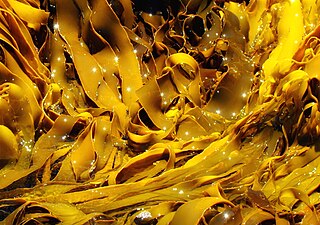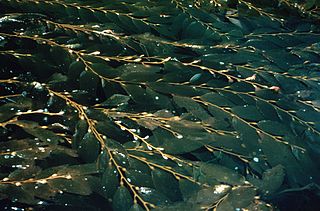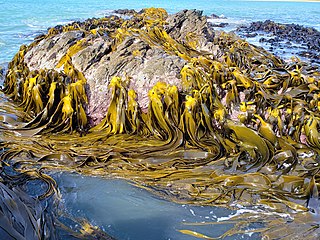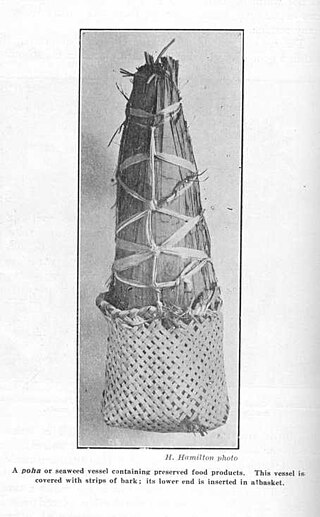
Kelps are large brown algae or seaweeds that make up the order Laminariales. There are about 30 different genera. Despite its appearance, kelp is not a plant but a stramenopile, a group containing many protists.

Brown algae are a large group of multicellular algae comprising the class Phaeophyceae. They include many seaweeds located in colder waters of the Northern Hemisphere. Brown algae are the major seaweeds of the temperate and polar regions. Many brown algae, such as members of the order Fucales, commonly grow along rocky seashores. Most brown algae live in marine environments, where they play an important role both as food and as a potential habitat. For instance, Macrocystis, a kelp of the order Laminariales, may reach 60 m (200 ft) in length and forms prominent underwater kelp forests that contain a high level of biodiversity. Another example is Sargassum, which creates unique floating mats of seaweed in the tropical waters of the Sargasso Sea that serve as the habitats for many species. Some members of the class, such as kelps, are used by humans as food.

Nereocystis is a monotypic genus of subtidal kelp containing the species Nereocystis luetkeana. Some English names include edible kelp, bull kelp, bullwhip kelp, ribbon kelp, bladder wrack, and variations of these names. Due to the English name, bull kelp can be confused with southern bull kelps, which are found in the Southern Hemisphere. Nereocystis luetkeana forms thick beds on subtidal rocks, and is an important part of kelp forests.

The biodiversity of New Zealand, a large island country located in the south-western Pacific Ocean, is varied and distinctive. The species of New Zealand accumulated over many millions of years as lineages evolved in the local circumstances. New Zealand's pre-human biodiversity exhibited high levels of species endemism, but has experienced episodes of biological turnover. Global extinction approximately 65 Ma resulted in the loss of fauna such as non-avian dinosaurs, pterosaurs and marine reptiles e.g. mosasaurs, elasmosaurs and plesiosaurs. The ancient fauna is not well known, but at least one species of terrestrial mammal existed in New Zealand around 19 Ma. For at least several million years before the arrival of human and commensal species, the islands had no terrestrial mammals except for bats and seals, the main component of the terrestrial fauna being insects and birds. As recently as the 14th century a component has been introduced by humans, including many terrestrial mammals.

Macrocystis is a monospecific genus of kelp with all species now synonymous with Macrocystis pyrifera. It is commonly known as giant kelp or bladder kelp. This genus contains the largest of all the Phaeophyceae or brown algae. Macrocystis has pneumatocysts at the base of its blades. Sporophytes are perennial and the individual may live for up to three years; stipes/fronds within a whole individual undergo senescence, where each frond may persist for approximately 100 days. The genus is found widely in subtropical, temperate, and sub-Antarctic oceans of the Southern Hemisphere and in the northeast Pacific from Baja California to Sitka, Alaska. Macrocystis is often a major component of temperate kelp forests.

Durvillaea is a genus of large brown algae in the monotypic family Durvillaeaceae. All members of the genus are found in the southern hemisphere, including Australia, New Zealand, South America, and various subantarctic islands. Durvillaea, commonly known as southern bull kelps, occur on rocky, wave-exposed shorelines and provide a habitat for numerous intertidal organisms. Many species exhibit a honeycomb-like structure in their fronds that provides buoyancy, which allows individuals detached from substrates to raft alive at sea, permitting dispersal for hundreds of days over thousands of kilometres. Durvillaea species have been used for clothing, tools and as a food source by many indigenous cultures throughout the South Pacific, and they continue to play a prominent role in Chilean cuisine.

Durvillaea antarctica, also known as cochayuyo and rimurapa, is a large, robust species of southern bull kelp found on the coasts of Chile, southern New Zealand, and Macquarie Island. D. antarctica, an alga, does not have air bladders, but floats due to a unique honeycomb structure within the alga's blades, which also helps the kelp avoid being damaged by the strong waves.

Durvillaea willana is a large species of southern bull kelp endemic to New Zealand.
Lessonia trabeculata is a species of kelp, a brown alga in the genus Lessonia. It grows subtidally off the coasts of Peru and northern and central Chile, with the closely related Lessonia nigrescens tending to form a separate zone intertidally. Lessonia trabeculata kelp have gained a great economic importance for alginate production, and its harvest has greatly intensified along the Chilean coast during past two decades
Saccharina dentigera is a species of brown algae, in the family Laminariaceae. It is native to shallow water in the northeastern Pacific Ocean from the Gulf of Alaska to Baja California.

Durvillaea poha is a large, robust species of southern bull kelp found in New Zealand.
Durvillaea amatheiae is a large, robust species of southern bull kelp found in Australia.

Durvillaea fenestrata is a large, robust species of southern bull kelp endemic to the subantarctic Antipodes Islands of New Zealand.

Durvillaea chathamensis is a large, robust species of southern bull kelp endemic to the Chatham Islands of New Zealand.

Durvillaea potatorum is a large, robust species of southern bull kelp found in Australia.

Pōhā are traditional Māori bags made from southern bull kelp, which are used to carry and store food and fresh water, to propagate live shellfish, and to make clothing and equipment for sports. Pōhā are especially associated with Ngāi Tahu, who have legally recognised rights for harvesting source species of kelp.

Laminaria nigripes is a species of kelp found in the North Atlantic and North Pacific within Arctic and subarctic waters including Vancouver Island, Haida Gawaii, Greenland, Iceland, Norway, Downeast Maine, and the Bay of Fundy. The species may be found exclusively in the Arctic, but frequent misidentification of samples has led to speculation and debate over whether the actual range is subarctic or Arctic. The species is commonly confused with Laminaria digitata and Laminaria hyperborea and is at risk from climate change.
Pleurophycus gardneri is a species of brown alga. It is a deciduous kelp, primarily found in lower, rocky inter-tidal and shallow, rocky sub-tidal locations and is one of the most abundant kelps found within the Pleurophycus Zone. It is not commonly present deeper in the ocean than 30m and is considered a stipitate kelp. P. gardneri forms aggregates of densities up to 10m−2. These kelp beds reside below giant kelp forests, and were therefore often overlooked by researchers for many years. This kelp has a range from Central California to British Columbia, Canada, with a lifespan of only 3 – 6 years.

Pyrophyllon subtumens is an obligate red algal epiphyte of Durvillaea southern bull-kelp, and is endemic to New Zealand.

Maullinia is a genus of intracellular, phytomyxid parasites found across the Southern Hemisphere though primarily in Chile, The Prince Edward Islands, South Africa, Australia, and New Zealand. These parasites infiltrate the cells of their brown algal hosts via cytoplasmic extensions called plasmodia that divide synchronously, becoming increasingly multi-nucleate and engulfing the host cell organelles as they grow. Eventually, as the plasmodia fill the entire cell volume, the host cells become hypertrophied and grow to 3- 4x their original size, showing up as swollen appendages or galls on the host tissue at a macroscopic level. These swollen regions will burst alongside the mature Maullinia plasmodia, releasing biflagellated zoospores to the inter- and extracellular space to disperse the infection further. Zoospores can come from sporangial plasmodia, as in M. ectocarpii, or from resting spores, as in M. braseltonii.
















